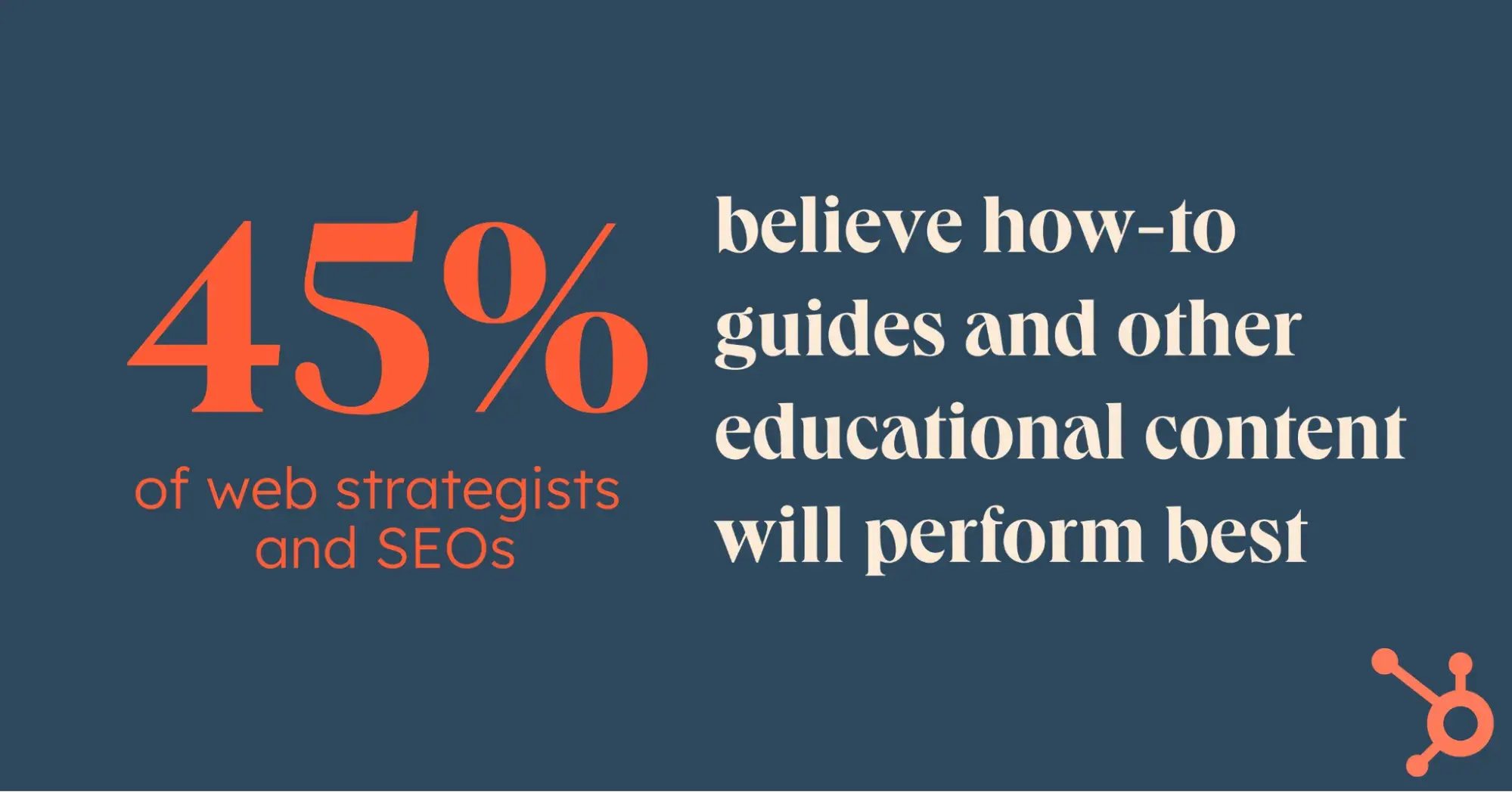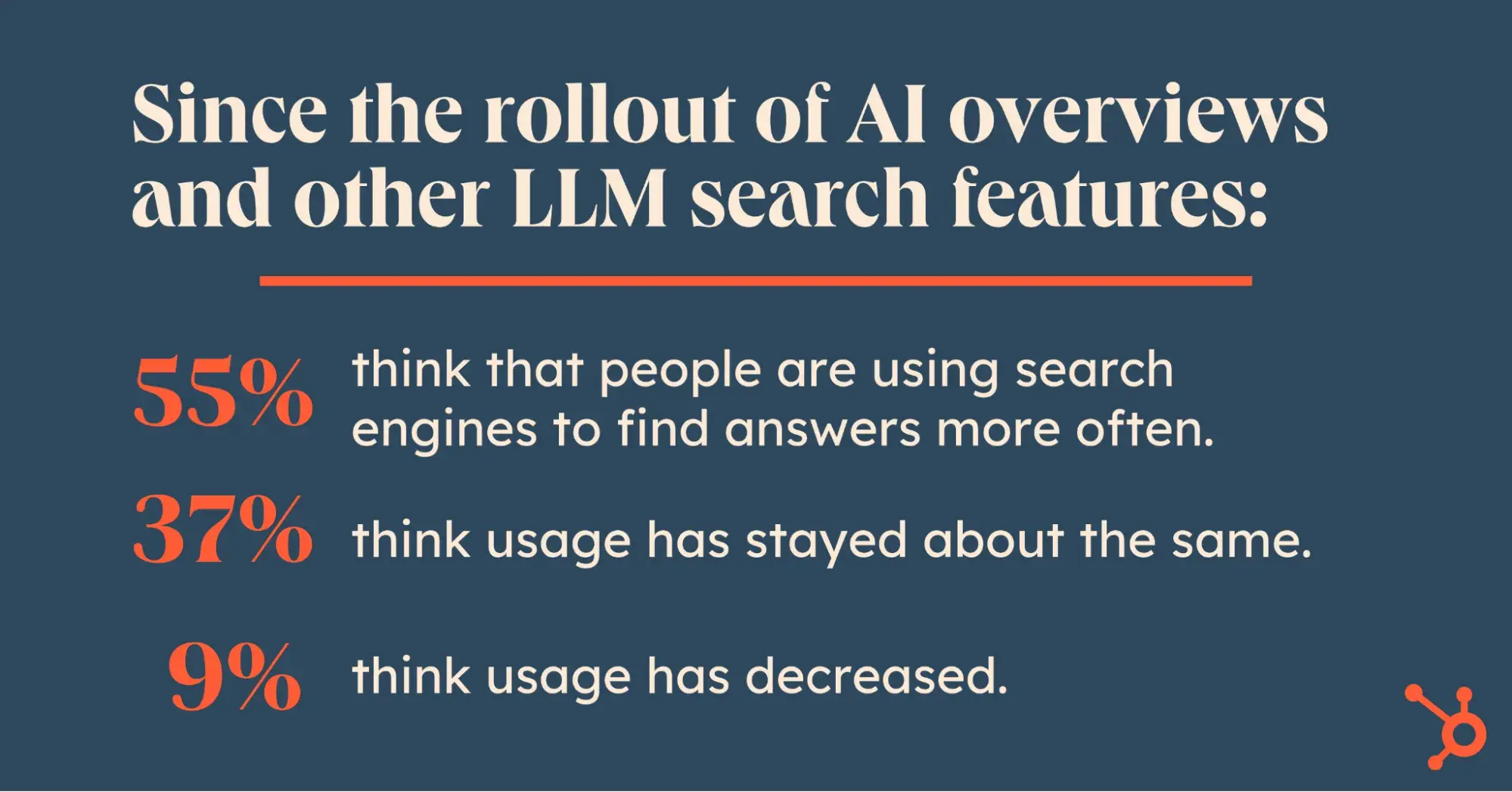Our view at Stack - Simplify growth with an all-in-one platform. Powerful marketing, sales, and support automation. Integrated CMS. Scalable software. Crafted for customer experience.
Since May 2024, Google’s AI Overviews (aka SGE) have reshaped the SEO world as we know it.
While content quality has always mattered, the stakes are now higher than ever as content must be not only informative and unique, but also easily digestible by Google’s AI.
![Download Now: The Annual State of Artificial Intelligence in 2024 [Free Report]](https://no-cache.hubspot.com/cta/default/53/b72f2b25-8cc9-4642-9a1b-1e675d3d273b.png)
This shift leaves a big question: What happens to your traffic if some of your content becomes redundant?
Check out insights from HubSpot’s SEO experts on which content to prioritize and what to avoid in the post-SGE landscape.
Which Types of Content to Lean into Ahead of Google’s SGE
1. Lean into personality-driven, thought-provoking content.
AI has a lot going for it. But, due to the nature of it being a robot, it inherently lacks one thing: a perspective.
Which is why you’ll want to ensure you start leaning into personality-driven thought leadership content that offers personal lessons, examples, and novel concepts that drive conversations forward.

In a survey we ran of 300+ U.S. web strategists and SEOs, we discovered that 37% think review and comparison content will thrive, while 27% see opinion pieces and thought leadership content as strong performers in this new landscape.
As Aja Frost, HubSpot’s Director of SEO Global Growth, puts it, “As a result of the AI evolution, there is an exponential increase in the amount of AI-written, low-value content. And, in response to that, Google is prioritizing first-person, credible, personality-driven content.”
This makes sense. Google needs its AI models to continue to improve based on new information on the web. And new information – including new perspectives and ideas — can only come from real people.
For instance, consider what happens when I ask Breeze Copilot, “How do I build emotional resilience as an entrepreneur?”

Copilot’s answer includes plenty of tangible steps toward building resilience. But it lacks the nuance and complexity of real life.
Which is why it’s more helpful for me to turn to this post: “Bounce Back: Five Founders on Building Emotional Resilience.”
In the post, one founder, Michael Plisco, says, “As founders, we often find ourselves so deeply attached to our business and its mission that it becomes difficult to distinguish ourselves from what we are building. In failure, you have to take a step back and realize that the failure of the business, regardless of the situation, does not equate to a failure of self.”
Plisco then recommends getting back in touch with the things that make you happy, from spending time with friends and family to activities you haven’t had the time for since launching your business.
Consider that advice compared to Copilot’s advice to “Embrace failures as learning opportunities, allowing you to adapt and grow from challenges.”
See the difference?
Ultimately, there are plenty of topics that deserve a quick, straightforward, cut-and-dry answer. I turn to Copilot all the time for topics like “Make me a workout plan,” “What is the top social media platform right now?” and “Please give me five questions I should ask in an interview about product development and AI.”
AI can‘t move the conversation forward into new territory with fresh, novel ideas. And it can’t fully relay the subtleties and nuances that many complex topics require. That’s where your content can truly shine.
2. First-person narratives will become increasingly crucial.
AI can round up a long list of tools and provide a comprehensive analysis of each, but it can’t describe its own unique experience testing the tools out.
Which is where first-hand perspectives will become critical.
As former HubSpot Marketing Manager and SEO Strategist Bianca (Binks) Anderson told me, “Productive Perspectives is a term we’re going to embrace at HubSpot to guide our writers ahead of Google’s SGE. For us, it means fully immersing ourselves in the topic and sharing our personal journey through first-person narratives.”

She continues, “We aim to showcase our hands-on experience by demonstrating the products, software, and tools we discuss, truly walking the walk.”
📍 It’s vital you take a look at your existing strategy and consider where you can incorporate first-hand expertise. Rather than writing “The Top 10 Marketing Automation Tools,” perhaps you use a first-hand angle like, “I Tried These 5 Marketing Automation Tools: Here’s My Favorite.”
Along with helping you rank in a post-SGE world, incorporating first-person expertise also helps you build brand trust. Your readers want to know you have real-life experience on the topics about which you’re writing.
Anderson adds, “We also believe in taking a clear and confident stance on a topic, supported by first-hand research and data.”
She continues, “We believe that forming and articulating insightful opinions is a hallmark of genuine expertise. With Productive Perspectives, we strive to provide valuable content that resonates with our readers.”
Here’s some interesting data on this matter: about 30% of SEOs think that content sharing personal stories and experiences is going to be hit the hardest by generative AI and LLM search engine integrations.
I can’t decide if this opinion is based on the belief that such stories will feel less authentic and personal or that LLM search engine integrations won’t be able to summarize these stories in AI Overviews well enough.
It seems both could be factors.
As generative AI relies more on general patterns instead of genuine human experiences, people worry that personal narratives will lose their impact, and most importantly — the “soul.”
3. You must incorporate E-E-A-T signals into your content.
Google’s Search Quality Evaluator Rating Guidelines rate E-E-A-T — which stands for Experience, Expertise, Authority, and Trustworthiness — as critical factors for ensuring your content ranks on Google, and E-E-A-T became increasingly important after Google’s SGE was released.
Which is why Rory Hope, HubSpot’s Head of EN Growth, advises all content creators to lean into these factors when creating content.
As he puts it, “When creating a piece of content, you’ll benefit from writing it through the real world experience of the author, whilst referencing the author or your company’s credentials to improve perceived expertise by search engines and users.”
He continues, “To improve authority, backlinks will remain important, so try to include primary research data or quotes when possible to make your content linkable and sharable. Depending on the content type, you should also add social proof or reviews onto the page, as this will help build trustworthiness.”
Hope recommends marketers read Google’s Search Quality Rater Guidelines to build a deeper understanding of E-E-A-T, which will help improve your visibility.
On the flip side, three experts from different niches and companies like Backlinko, Wistia, Rainbow Plant Life, and Angi adhere to slightly another approach — information gain. They advise writing SEO-optimized articles and adding only 10 to 40% of unique information.
Experts bake this up to the performance of their content and fear that “overloading your content with new information might make Google doubt its relevance to the query.”
My take? You should incorporate first-hand experience anyway, but that isn’t equal to information gain. Go through HubSpot blog posts, and you’ll see that our writers pour intensive research and external expertise into every post to make it unique and practical.
Yet all content incorporates keywords here and there — no SEO obsession.
4. Lean into long-tail queries.
For a while now, marketers have heard the power of long-tail queries for ranking higher in the SERPs.
As a refresh: Head terms like “blogging” are generally searched for frequently, and are harder to rank for compared to long-tail phrases. So when considering your SEO strategy, you’ll want to make a list of long-tail phrases that could help you capture more traffic.
“How to write a blog post: a beginner’s guide,” for instance, is likely easier to rank for than “blogging.”

45% of SEOs believe “how-to” guides and other educational content will perform best as generative AI and LLMs become more integrated with search engines.
And speaking about how-to guides, you’ll often see AI overviews using ordered lists for step-by-step instructions, according to the Surfer survey.

Source
Senior Technical SEO Specialist Sylvain Charbit believes such types of queries will become increasingly important in a post-SGE world.
“Prioritizing long-tail queries will become even more important as AI answers from Google are usually better in this case,” he said. “Optimizing images and content around these more in-depth questions could lead to more visibility in the AI-generated responses.
Long story short: People are now writing long phrases to get short, straightforward, “ASAP” responses.
And when I say short, I mean that AI overviews are usually around 157 words long. That gives you only about 984 characters to answer a question directly or make the content interesting enough to get people to click and find out more.
It’s tough, but it really sharpens your focus and keeps you from wandering off-topic. You know exactly where you need to go and what to give your users.

And how will all this impact search engines?
Well, 55% of SEOs from our survey believe that since the rollout of AI overviews and other LLM search features, people are using search engines to find answers more often.
Meanwhile, 37% think usage has stayed about the same, and only 9% feel it has decreased.
I’m kind of torn between thinking that people are searching for answers more frequently and believing that usage has remained roughly the same. But I’d bet that it definitely won’t go down.
Moreover, we must take in traffic generated by AI chatbots — from ChatGPT and Gemini to Claude and Copilot. In October, I saw an influx of posts sharing that they had started getting more traffic from chatbots.

Source
Don’t Fear Change — Just Adapt Your Strategy
To rank high, you have to be ready for even more changes ahead. Google isn’t slowing down, and AI is advancing way faster than expected. But that doesn’t have to be a bad thing. We just need to prepare ourselves and stay open to change. (Good news: AI won’t take our jobs.)
Your SEO and content strategy teams are ready to test, iterate, and experiment to find out which new content strategies work best for your business.
Take a look at The SEO Evolution: Expert Insights into the Future Landscape of Search if you’re interested in learning more about how SEO will change in 2025 and beyond.
Editor’s note: This post was originally published in September 2023 and has been updated for comprehensiveness.
![]()
If Hubspot is of interest and you'd like more information, please do make contact or take a look in more detail here.
Credit: Original article published here.
